One of the first things to go is spontaneity.
In my 20s I would think nothing of hopping in my Datsun 510 and driving to Vancouver if the opportunity presented itself. Indeed I did just that, once.
But then mental atrophy sets in. And the need to have the breakfast cereal out of the same bowl every morning becomes increasingly important. Part of this is simply complexity: it’s harder to coordinate a small platoon of two adults, one teen and one dog into a sudden outburst of spontaneity. But there’s more to it than that: well-worn ruts, as Bembo showed us, can prove very alluring.
Which is why sometimes having someone email you, at the very last minute, with a “Hey, we’ll be in Charlottetown tonight, can we park in your driveway” can be an welcome shock to the system.
Which is exactly what happened yesterday: my friend Julie is acting as aide-de-camp for her friend Nicole while Nicole makes her way from St. John’s, Newfoundland to Montreal, stopping every 50 km to paint the Trans-Canada Highway. They are now 15 days in, having made their way across Newfoundland (twice, actually, as they had to first get to St. John’s) and Cape Breton, and opting to take the more interesting Prince Edward Island leg of the highway over the less interesting Nova Scotia one (who knew the Trans Canada had forks?).
So not only was there an unexpected injection of spontaneity into our life, but it had an right-up-my-alley artistic hook to boot.
And, so, this was the scene in our driveway this morning:

By all rights Nicole and I should know each other: we lived in Peterborough, Ontario at the same time for a number of years. Hung with a similar crowd. We even went to the same high school, albeit in different years. But, as near as I can determine, our paths never crossed. At least in a way that I can remember. (It’s also possible the we were roommates and that I’ve just completely forgotten several years of my life; this is not as far-fetched is it reads).
This morning Nicole will backtrack toward the Wood Islands ferry, stopping 18 km this side, which, added to the 32 km on the Nova Scotia side since her last painting, makes an even 50. This will put her, I reckon, in downtown Pinette. And would make PEI painting number two land somewhere around the North River causeway. And painting number three almost exactly at the end of the bridge (how convenient our kilometerage is!).
Along the way I’m hoping that she can intersect with a Guardian photographer and a CBC crew – hastily arranged late nite emails went out that the journalistic community yeomanly responded to quickly – and so Islanders will be able to learn a bit more about the project too.
In the meantime, we had a nice dollop of spontaneity land in our midst, got to renew ties with Julie, and start ties with Nicole.
As you’re making your way from Wood Islands to Borden today, watch out for painter.
I am a big fan – and a daily user – of the open source Kodi media centre. I run it on an inexpensive Raspberry Pi computer hooked up to our 20 year old Sony television and, thanks to video services that have Kodi plug-ins, like USTVnow and YouTube, I have a rich pool of content to use to supplement our steady diet of Netflix (which we watch via our Nintendo Wii).
Something that I’d been missing, though, was a way to watch Compass, the local CBC evening news here in Prince Edward Island. As a vocal Compass advocate, this absence from my supper hour seemed downright unpatriotic.
I’ve been able to bodge together a solution that works via an iPad, AirPlay and Kodi’s ability to receive AirPlay streams. But it only works some of the time (most noticeably and helpfully on provincial election night), and, for some reason, seems unable to play me Compass.
And thus I was happy to encounter news of a CBC plug-in for Kodi, which held the promise of native-to-Kodi access to Compass (and a range of other CBC programs I’ve been missing).
And the plug-in works.
I was able to watch Dragon’s Den with my breakfast this morning and it was rock solid.
Unfortunately, Compass seemed to be missing from the mix. Navigating through the Kodi UI to News, and then Local News Shows, results in just a single program, Here and Now, from St. John’s, Newfoundland:


This isn’t the fault of Kodi nor the CBC plug-in, though: if you navigate through the CBC’s own (dreadful) video gallery, following the same path, you end up with the same result, showing a single local news program:

Navigating to video from the Compass website ends one up at a page with breadcrumbs that look like this:
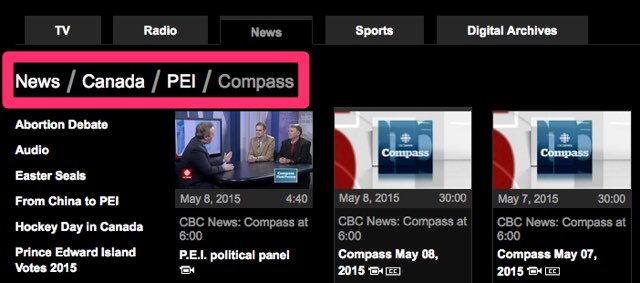
Which suggested that if, rather than following News > Local News Shows, I instead followed News > Canada > PEI, I might find the promised land. And, sure enough, it’s all there:
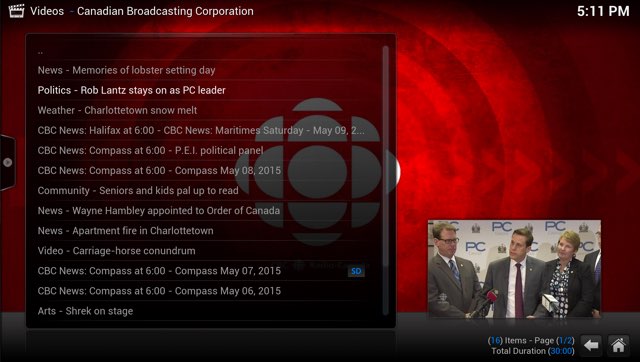
And here’s Kodi happily playing last Thursday’s episode of Compass:
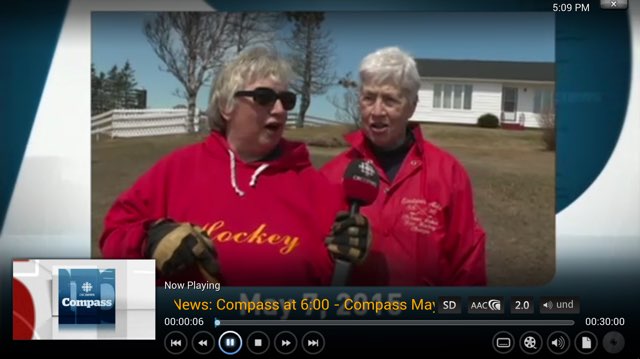
I am again a happy Compass patriot.
(Warning: this really is a very sad story; don’t read it unless you’re prepared to be sad afterwards)
Seventy years ago this weekend, on the front page of the May 9, 1945 edition of The Charlottetown Guardian appeared what is perhaps the saddest story I’ve every read, under the headline “Sad Fatality Mars Day of Celebration” and concerning the death of 9 year old Charles Dalton Stewart in the VE Day parade in Charlottetown:
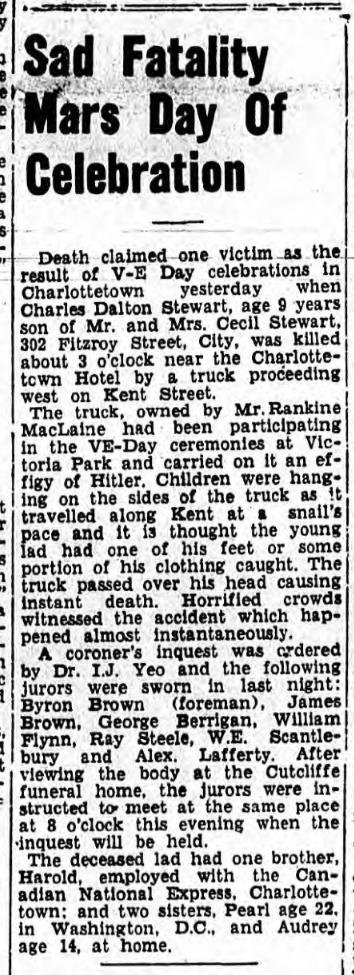
It’s impossible for me to conceive of the depth of grief that must come from losing a child, especially after living through the war, and on a day on which the rest of your community, province and country is lost in a reverie of joy over the war’s end.
With a haste that, contrasted with current practice, was impressive, the coroner’s inquest was, indeed, held that evening, and the following day’s newspaper contained the ruling:
A coroner’s jury, Inquiring last night Into the circumstances surrounding the death Tuesday afternoon of ten-year old Charles Stewart, brough in the following verdict: “We In find the the said Charles Stewart came to his death in the City of Charlottetown in Queen’s County. on Tuesday, May 8, 1945, by being run over by a motor truck, causing a fractured skull. No blame is attached to Mr. Lord, driver of the truck.
Dr. I. J. Yeo, coroner, presided at the inquest and the Attorney General was represented by Mr. G. R. Holmes.
Dr. I. Rachmel, who was the first witness, said he was called to the P. E. Island Hospital to examine the dead body of a boy. Found the boy had a multiple fracture of skull. There was no other signs of injury to the body. Pressure had been exerted on head from opposite sides and brain tissue had been squeezed out through mouth and other orifices of head. Death could have been caused by heavy wheel passing over head.
Fred McDougall, 320 Kent Street. said he was sitting on truck and felt a jar. Gordon Lord was driving. He was sitting in back with Leo Dowling. Charles Stewart was not on truck. The truck was going less than or mile an hour. Felt the jar when truck was between Frank Hennessey’s and Charlottetown Hotel.
Gordon Lord, 5 Spring Street, said he was driving truck with two others sitting beside him. Witness did not know Charles Stewart, until he saw him lying on the street. Witness felt a jar. He was driving very slowly, There were a lot of children clinging to running boards of truck.
Leo Dowling, 373 Kent Street, said he was sitting with Fred McDougall at back of truck on a car cushion. A few children were hanging on rear of truck and on sides. Witness felt a small bump. Saw Stewart boy lying on street behind and on right side of truck. Thought rear wheel went over him.
Sgt. Allan McInnis, City police, said he was told by an airman that a boy had been killed on Kent Street. Ran down to scene of tragedy, opposite A. A.. Hennessey’s. Found small boy face down on street in a pool of blood. Boy was still breathing and witness lifted the boy’s face out of blood to prevent him smothering. Blood was gushing from both nostrils. Witness thought boy was dead when ambulance arrived few minutes later. Witness said truck was moving very slowly as it was impossible to go faster on account of large crowds of people. Did not know who boy was until brother came up before ambulance left and said, “This Is my little brother.”
Fred McKenzie, 278 Fitzroy Street, said he had one foot on side of truck and was hanging on. Stewart was on other side trying to get on. Witness did not see Stewart fall but saw rear wheel pass over him.
Albert Vincent, 247 Grafton Street said he was on truck with Leo Dowling. Had got on when truck left Victoria Park. Witness was told by driver to try to stop the kids from pulling off Hitler’s boots (truck was carrying an effigy of Hitler). Lot of young lads hanging on truck. Witness felt rear right wheel raise up near CFCY, Witness got off when truck stopped. An airman and a sailor grabbed witness’ hands and formed a ring around Stewart to prevent people crowding prostrate body. Witness wanted to give himair. Witness said it was impossible to get kids off the sides of truck. They would not listen.
Rankine McLaine said he owned the truck. It was of 6000 pounds capacity and had never been out before. There was no body on truck. Gordon Lord was a reliable and careful driver, witness said.
The jury, who only took a few minutes to reach a verdict included Byron Brown (foreman), James Brown, George Berrigan, William Flynn, Ray Steele, W. E. Scantlebury and Alex Lafferty.
The funeral for Stewart was held the following day, May 11, 1945, at the family’s home at 302 Fitzroy Street:
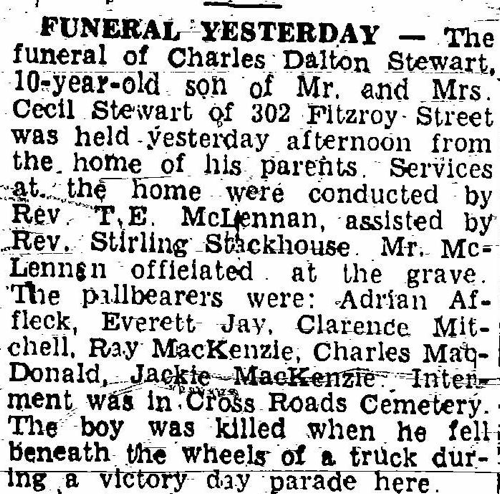
Cross Roads Cemetery is located across the bridge from Charlottetown behind Cross Roads Christian Church. Stewart is buried there, under a headstone featuring a lamb, beside his parents Cecil and Laura who died in 1977 and 1965 respectively:

The energetic folks at goPEI! invited me to join them today for the announcement of Walk a Lot, their project to encourage Islanders to get out and explore the Samuel Holland township lots in this, the 250th year since they were first surveyed. I was there to talk about WhatsMyLot.com, my own little contribution to the Holland 250 commemoration.
One little hack begets another, and I was prompted, as the result of a conversation at the launch event, to calculate the number of lots through which the Confederation Trail passes.
Which, in turn, prompted me to wonder: how many lots have I passed through in the last year?
Fortunately, I’ve been tracking my location, minute by minute, for the last year, so this is an easy question to answer using exactly the same techniques that I used for the trail.
I started with the Holland Map and my personal GPS breadcrumbs:
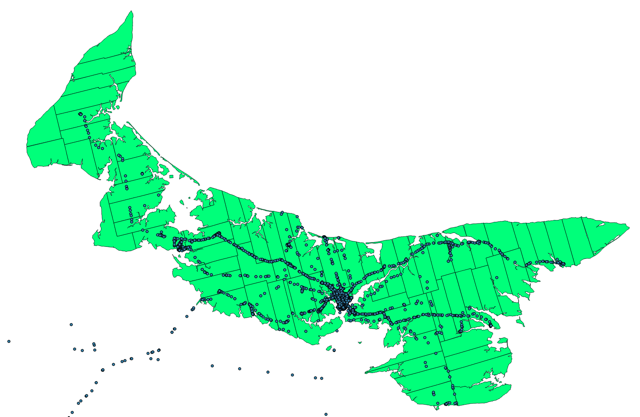
I then used the point-in-polygon tool of QGIS to calculate how may lots I’d set foot (or car tire) in over the last almost-365-days.
The result?
I’ve visited 52 lots and 2 royalties over the last year.
The lots and royalty that I haven’t visited yet are:
- 1
- 2
- 3
- 4
- 7
- 8
- 9
- 15
- 18
- 20
- 46
- 47
- 54
- 59
- 61
- PRINCETOWN
Here’s what they look like on a map, with the lots I haven’t visited shaded in blue:
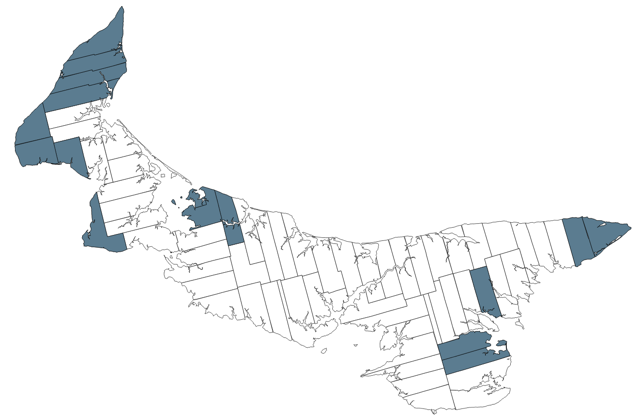
It’s obviously high time to go on a tour of public schools in West Prince, and to visit Lower Montague and Panmure Island, Bridgetown, East Point, Malpeque and the Evangeline Region.
TL;DR The Confederation Trail passes through 47 (of 67) township lots and 2 (of 3) royalties on Prince Edward Island.
I demonstrated the WhatsMyLot.com open web app this morning at a media launch for a “Walk-a-Lot” project, and I met a public servant who works with the Confederation Trail afterwards. As we chatted it occured to me to wonder how many Samuel Holland Township Lots the Confederation Trail passes through. And so I decided to try to find out.
To start I grabbed the cleaned-up and corrected Township Lots GIS layer as a Shapefile and the Confederation Trail Inventory GIS layer as a Shapefile.
I loaded both into QGIS, an open source GIS application.
Before I went any further I had to change the coordinate reference system (CRS) on the Township Lots layer to match the Confederation Trail; I right-clicked on the layer in QGIS and selected Save As…
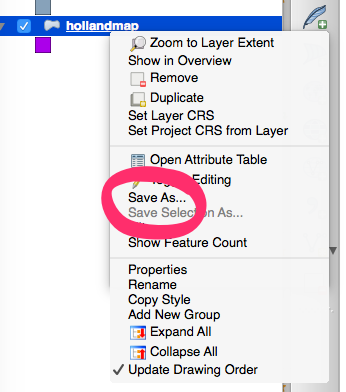
and then set the CRS field by clicking on Browse:

and selecting NAD83(CSRS) / Prince Edward Isl. Stereographic (NAD83) EPSG:2954:
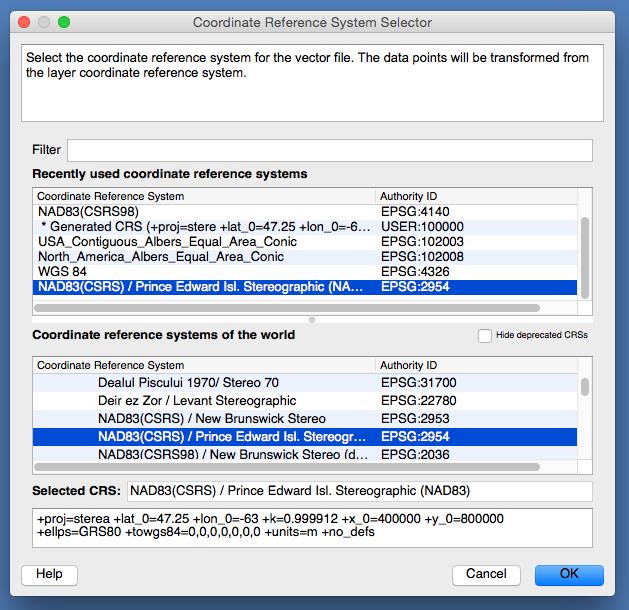
Finally, I selected Vector > Analysis Tools > Points in Polygon and selected the Township Lots map as the “polygon vector layer” and the “Confed_Invent_2006” layer as the “point vector layer”, and selected a new Shapefile – intersect.shp – to save the result in:

After 30 seconds or so, the new layer was added to the map; to see the results I right-clicked on the new layer and selected Open Attribute Table:
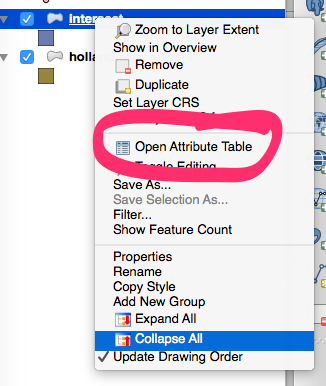
The “attribute table” looks like a spreadsheet, and in the PNTCNT column is a list of the number of Confederation Trail points that fall inside the given lot. For example, there are 123 points that fall inside Georgetown Royalty, and 99 points that fall inside Lot № 36, but no points at all inside Lot № 30:
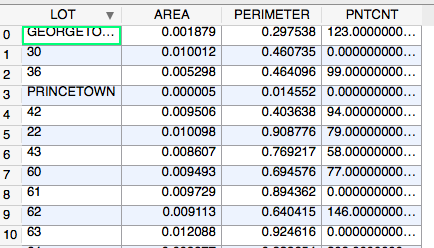
Counting the lots and royalties with a PNTCNT value of more than zero told me the number of lots (47 of 67) and royalities (2 of 3) that the Confederation Trail passes through.
Note that the “Confederation Trail Inventory” layer that’s available from the province is 9 years out of date, and does not include the new spurs from Stratford to the east, so it’s likely that the true number of lots is closer to 50.
Here’s what the resulting map of Prince Edward Island looks like, with the lots and royalties through which the trail passes highlighted in blue:
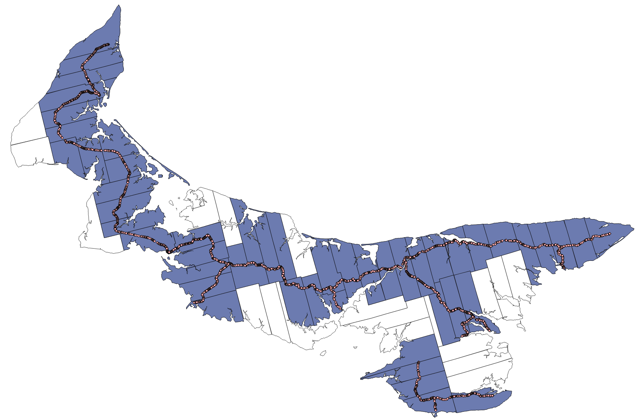
My academic colleagues at Robertson Library, University of PEI, have a lovely new wayfinding sign at the entrance to the library; it’s very well-designed, and will be a big help to patrons:

What strikes me as odd, though, is the library tagline used at the top of the sign: “Your place to get work done!”
Of all of the ways I would choose to describe a library, “a place to get work done” would appear very low on the list.
“Your place to explore the wonders of the universe!”
“Your wormhole to knowledge!”
“Your collegial gateway to insights through resources!”
“Your place for books, computers and coffee!”
“Your place to rock your learning with secret library sauce!”
All yes.
But “get work done”?!
Libraries are amazing assemblages of people, tools and resources. They are not workhouses.

A couple of years ago the “sit-stand” (or simply “standing”) desk wind blew through silverorange, and, prompted by their experiments (and by their testimony that their emergency room doctor clients said, in essence, “you’re going to die if you sit all the time,” or something to that effect), along with some advice from my capable ergonomics consultant, Marie Brine, I decided to investigate for myself.
My first go was to order a Varidesk, which appealed to me because it was easy to flip back and forth from sitting to standing, because I could just plop it on top of my existing desk, and because it was relatively inexpensive compared to other options ($420 with shipping from Fitterfirst in Calgary). While it was everything it promised to be, it suffered from one insurmountable problem for me: I couldn’t adjust it so that it was both tall enough in the “standing” position and at the right height in the “sitting position.” I could have hacked it to work, but I decided not to, reasoning that it made more sense to find a solution that actually worked for me without the need to improvise. Here’s what the Varidesk looked like in my office, before I returned it:

At this point – over a year ago – inertia took over, and I set the standing desk idea aside, fully expecting to return to it any day now.
And then the days and weeks and months passed. Until this spring, when a flare up of some work-related physiotherapy issues (the same issues that had spurred me to action last year) had me revisit the problem.
I’d been dropping in on The Best Standing Desks article at The Wirecutter every month or two over the last year and recently their recommendation switched to the Jarvis from Ergo Depot, and after reading and watching reviews of this option, it seemed like it would work well for me: they only sell the motorized frame to Canadians, without a tabletop, but I was able to confirm with their customer service people that the frame would work with my existing desk (a federal government surplus desk I bought in 2003 from The Clearance Centre in Summerside). This tabletop measures 78” by 30” (198 cm by 76 cm) and it was already strapped to a mechanism that allowed it to be adjusted up and down (albeit not as high as “standing” height), so all I would need to do is to remove it from this contraption and add the Jarvis base.
I placed the order on Ergodepot’s website on April 19. I ordered the base along with a Humanscale M8 flat panel monitor arm to allow me to have different positions for my Apple Thunderbolt 27” display for sitting and for standing. The Jarvis frame was $519 US, the monitor arm was $379 US and shipping was $184 US for a total of $1082 US.
The Jarvis frame arrived 11 days later on April 30 by FedEx Ground.
Here’s what it looked like freshly-unpacked from its box:
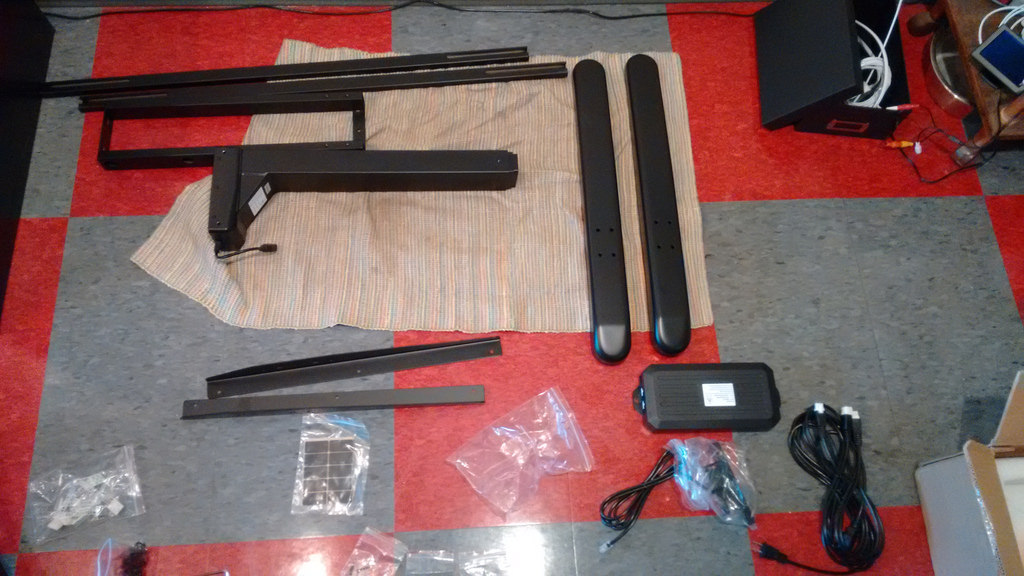
It took me about 2 hours to take apart the old desk, to assemble the parts of the Jarvis frame and to mount the old tabletop to the frame. My only complaint about the process was that the printed manual included with the frame was sized for 25 year old eyes and I have 49 year old eyes, so I had to take photos and blow them up on my phone to see the details. But the instructions, once I could see them, were straightforward and the frame came together without issue.
Here’s what it looks like in the “standing” position (44.4 inches for me):
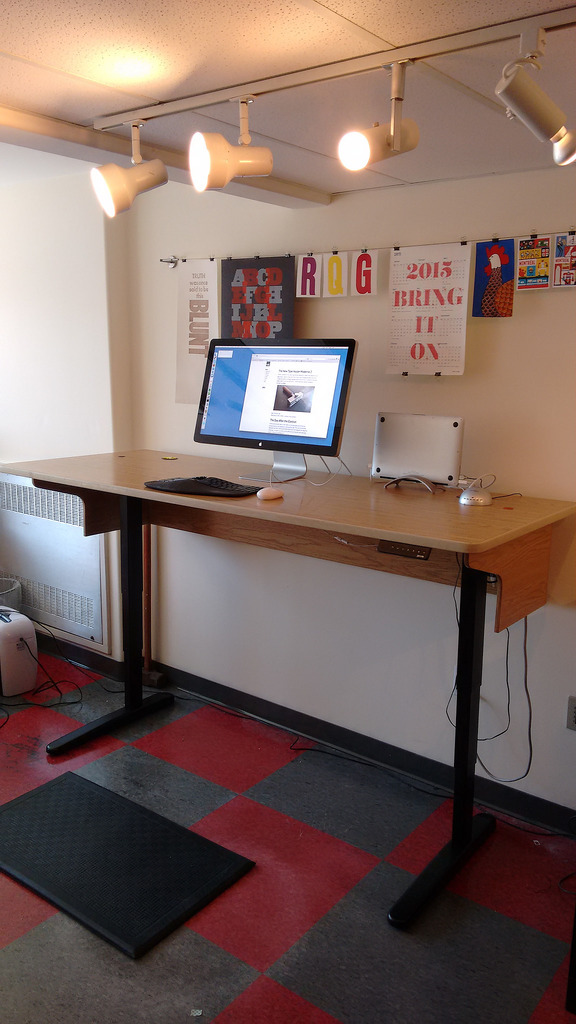
And here’s the “sitting” position:

And here’s a little video of the transition from sitting to standing and back (note that I paid $20 extra for the digital controls, which several reviewers recommended; they have 4 memory positions):
The desk has only been assembled and operating for a few hours now, so I’ll follow up later with a more detailed review. I did, however, write half this blog post while sitting and half while standing, and I enjoyed the contrast. More to follow.
When a pointer to The New Type Holder Moderne 2 came to my attention via Briarpress, I had to order one: I do not give into indulgences often, but this is a tool that seems as though designed specifically for me. It arrived in the post today, and it is as truly wonderful – finely-machine, cleverly-designed, lovingly-packaged.

Times were simpler back in 1931 when, on the day after the Provincial General Election, the headline in The Guardian was “The Lea Government Defeated And The Conservatives Were Returned With Magnificent Majority Yesterday.” It wasn’t, in other words, difficult to tell where your morning paper’s political sympathies lay:
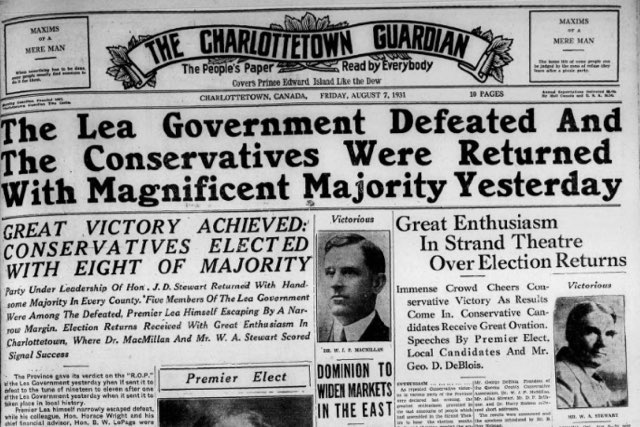
By way of making it easier to explore these “day after the election” editions of the newspaper, I’ve worked with my colleagues at Robertson Library to assemble a gallery of them on the front page of IslandNewspapers.ca:
The newspaper digitization project at the library includes the issues covering the 1900 through 1962 elections (with 1959 a missing year, and so a missing election).
Thanks to a nudge from my friend Dave Cairns, I’ve dipped my toe into the waters of IPv6, and I’m noting what I did here for future reference.
Enabled ICMP on my Bell Aliant-provided Actiontec R1000H router; this is done from the Firewall tab by enabling WAN PING mode.
Visited to https://www.tunnelbroker.net/ and registered for a free Tunnelbroker account.
Clicked Create Regular Tunnel in the left sidebar.
As IPv4 Endpoint (Your side), I entered the IP address that Bell Aliant assigned to my Actiontec R1000H router (it appears as “Modem IP Address” on the main status screen).
Selected the Toronto tunnel server and clicked Create Tunnel.
From my MacBook Air’s Terminal app:
sudo ifconfig gif0 tunnel 192.168.2.12 216.66.38.58 sudo ifconfig gif0 inet6 2001:470:1c:7f::2 2001:470:1c:7f::1 prefixlen 128 sudo route -n add -inet6 default 2001:470:1c:7f::1
The 192.168.2.12 IP address above is the LAN IP address of my MacBook Air.
In the MacBook Air’s System Preferences under Network | Wi-Fi | DNS, added IPv6 nameservers from the Tunnelbroker tunnel information page (2001:470:20::2 and 74.82.42.42), in addition to the IPv4 ones from Google that were already there.
That’s it.
At this point I could then visit http://www.test-ipv6.com/ and see the following:
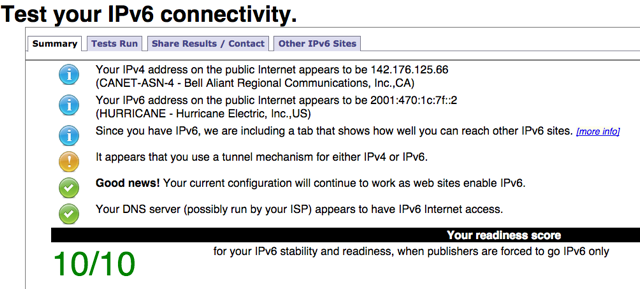
And, from the Mac OS X command line:
# ping6 ns.upei.ca PING6(56=40+8+8 bytes) 2001:470:1c:7f::2 --> 2001:410:e000:903:1::1 16 bytes from 2001:410:e000:903:1::1, icmp_seq=0 hlim=56 time=77.641 ms 16 bytes from 2001:410:e000:903:1::1, icmp_seq=1 hlim=56 time=98.467 ms 16 bytes from 2001:410:e000:903:1::1, icmp_seq=2 hlim=56 time=65.694 ms 16 bytes from 2001:410:e000:903:1::1, icmp_seq=3 hlim=56 time=71.714 ms
I’m fairly certain this is all going to fall to pieces when my DHCP lease from Bell Aliant expires; by that time, though, I hope that Dave has read this far and is ready for the next dose of help.
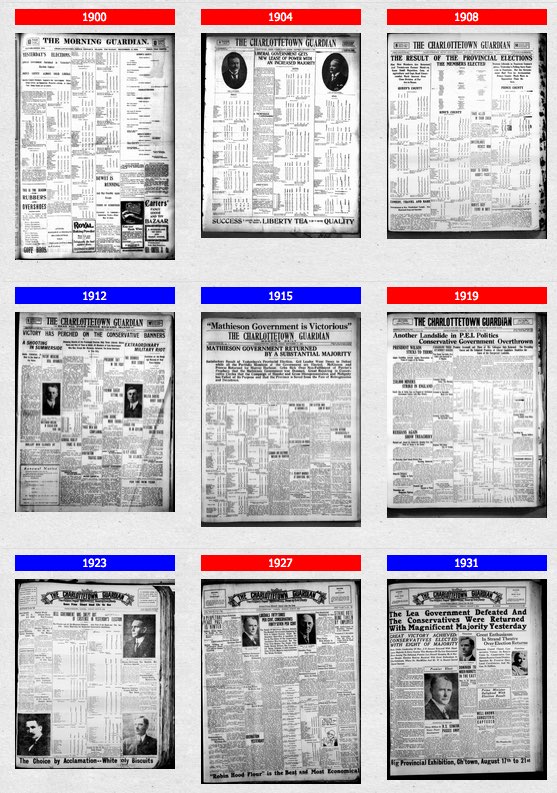
 I am
I am